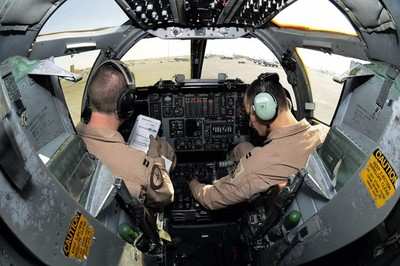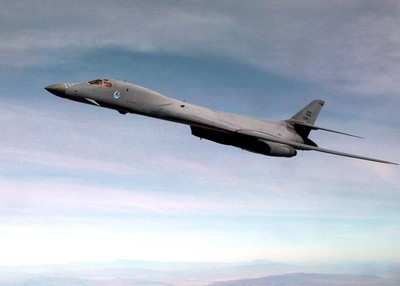Mon, Apr 21, 2014
Testing Of New Software Began April 1
In order to keep the B-1B Lancer's capabilities ready to operate now and well into the fast-paced integrated battlefield of the future, the 419th Flight Test Squadron began testing Sustainment Block 16A software upgrades April 1. The SB 16A software is a fielding configuration software that will provide enhancements to the recently added glass cockpit configuration.

The glass cockpit is part of the Lancer's Integrated Battle Station modification that increases Link 16 capabilities. Link 16 allows all equipped military aircraft, as well as naval and ground forces, to interact and exchange overall tactical pictures in near-real time.
"The SB 16A configuration is expected to improve situational awareness to all crew members, increase the maintainability of the B-1B and provide data link capabilities to the field," said Capt. Carlos Pinedo, a 419 FLTS B-1 Test Pilot and flight commander. "Major software enhancements include improved integration between the B-1(B's) offensive avionics system, various onboard sensors and the data link, which results in improved battlespace awareness for both the B-1(B) aircrew and fellow strike package assets.
"The new displays allow aircrew members to seamlessly pass information and accomplish tasks that were once crew-position dependent," he continued. "The overall result is improved situational awareness and a reduction in crew workload, leading to improved combat effectiveness. The improved sustainability of the B-1B as a result of this program will help maintain the Air Force's long-range strike capability for many years to come."

According to Raymond So, the 412th Test Engineering Group project lead engineer, the focus of the test squadron after April 1 is to identify any deficiencies as early as possible so that the customer has time to resolve issues and provide the warfighter with the best available product.
"The greatest challenge for the team (currently) is to understand the software maturity and requirements flowing into SB 16A," So said. "The new displays and interface will have such a great impact on B-1B tactics and situational awareness that the team is learning and identifying how the new aircraft will be used. This has also changed our testing philosophy. We have had to adapt our testing to the new system that we are given."
Pinedo noted that the squadron plans to test the upgrades in four phases, in which the final phase will be the configuration that the warfighter will see.
"SB 16A testing builds on and merges prior tests, which included, but are not limited to, the Integrated Battle Station with the new glass cockpit design, updated Inertial Navigation Systems and the B-1B Radar Reliability and Maintainability Improvement Program," Pinedo said. "The flight and ground tests will be accomplished in four phases, each relating to a different software drop -- ultimately resulting in the first operational fielding of the new cockpit design."
According to the test team, SB 16A testing is projected to end in February 2015.
(B-1 Lancer image from file)
More News
He Attempted To Restart The Engine Three Times. On The Third Restart Attempt, He Noticed That Flames Were Coming Out From The Right Wing Near The Fuel Cap Analysis: The pilot repor>[...]
Make Sure You NEVER Miss A New Story From Aero-News Network Do you ever feel like you never see posts from a certain person or page on Facebook or Instagram? Here’s how you c>[...]
From 2009 (YouTube Edition): Leading Air Show Performers Give Their Best Advice for Newcomers On December 6th through December 9th, the Paris Las Vegas Hotel hosted over 1,500 air >[...]
Aero Linx: NASA ASRS ASRS captures confidential reports, analyzes the resulting aviation safety data, and disseminates vital information to the aviation community. The ASRS is an i>[...]
“For our inaugural Pylon Racing Seminar in Roswell, we were thrilled to certify 60 pilots across our six closed-course pylon race classes. Not only did this year’s PRS >[...]
 NTSB Final Report: Rutan Long-EZ
NTSB Final Report: Rutan Long-EZ ANN FAQ: Turn On Post Notifications
ANN FAQ: Turn On Post Notifications Classic Aero-TV: ICAS Perspectives - Advice for New Air Show Performers
Classic Aero-TV: ICAS Perspectives - Advice for New Air Show Performers ANN's Daily Aero-Linx (06.28.25)
ANN's Daily Aero-Linx (06.28.25) Aero-News: Quote of the Day (06.28.25)
Aero-News: Quote of the Day (06.28.25)




